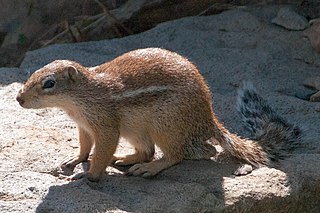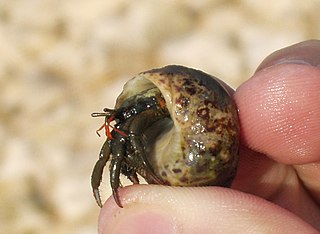
Selaginella is the sole genus in the family Selaginellaceae, the spikemosses or lesser clubmosses, a kind of vascular plant.

The lesser white-fronted goose is a goose closely related to the larger greater white-fronted goose. It breeds in the northernmost Palearctic, but it is a scarce breeder in Europe, with a reintroduction attempt in Fennoscandia.

Tringa is a genus of waders, containing the shanks and tattlers. The genus name Tringa is the Neo-Latin name given to the green sandpiper by the Italian naturalist Ulisse Aldrovandi in 1599. They are mainly freshwater birds, often with brightly coloured legs as reflected in the English names of six species, as well as the specific names of two of these and the green sandpiper. They are typically associated with northern hemisphere temperate regions for breeding. Some of this group—notably the green sandpiper—nest in trees, using the old nests of other birds, usually thrushes.

The spotted redshank is a wader (shorebird) in the large bird family Scolopacidae. The genus name Tringa is the Neo-Latin name given to the green sandpiper by Aldrovandus in 1599 based on Ancient Greek trungas, a thrush-sized, white-rumped, tail-bobbing wading bird mentioned by Aristotle. The specific erythropus is from Ancient Greek eruthros, "red", and pous, "foot".

Neoboletus luridiformis, also previously known as Boletus luridiformis and (invalidly) as Boletus erythropus, is a fungus of the bolete family, all of which produce mushrooms with tubes and pores beneath their caps. It is found in Northern Europe and North America, and is commonly known as the scarletina bolete, for its red pores, which are yellow when young. Other common names include the red foot bolete, dotted stemmed bolete, or dotted stem bolete.

The red-legged tinamou or red-footed tinamou, is a ground-dwelling bird found in the tropics and lower subtropics of northern South America.

Typhula incarnata is a fungal plant pathogen in the family Typhulaceae.
Typhula ishikariensis is, along with Typhula incarnata, the causal agent of grey snow mould, an obligately parasitic plant pathogen that can destroy turfgrass when covered for a long period with snow. It is a particular problem on golf courses established in unsuitable areas. More importantly, it can also damage crops of winter wheat. The species was described as new to science in 1930 by Japanese mycologist Sanshi Imai. The varieties canadensis and ishikariensis were described in 1978. There is a wide variety within the species and not all authorities agree as to subspecies, or even whether it should be monophyletic.

Pseudochorthippus parallelus, the meadow grasshopper, is a common species of grasshopper in the tribe Gomphocerini. It is found in non-arid grasslands throughout the well vegetated areas of Europe and some adjoining areas of Asia. It is a well-studied organism in the discipline of evolutionary biology and was an early and important model system for the study of European phylogeography.

The red-thighed sparrowhawk, alternatively known as the red-legged sparrowhawk or western little sparrowhawk, is a species of sparrowhawk in the family Accipitridae from western and northern central Africa.

The striped ground squirrel is a species of squirrel native to Africa. It was first described by Geoffroy in 1803, but the binomial authority is sometimes incorrectly cited as "Desmarest, 1817". There are six subspecies. It is a moderately large ground squirrel with sandy-brown or dark-brown fur with a white lateral stripe and whitish underparts. Adults live alone or in pairs in a simple burrow with a central nest, foraging, mostly on the ground, for seeds, nuts and roots, and caching excess food under stones. This is a common species with a wide range and the International Union for Conservation of Nature has rated its conservation status as being of "least concern".

Clibanarius erythropus is a species of hermit crab that lives in rockpools and sublittoral waters. It is found in the Mediterranean Sea, Black Sea and eastern Atlantic Ocean from the Azores to Brittany, the Channel Islands and as far north as the south Cornwall coast. Individuals may grow up to a carapace length of 15 millimetres (0.6 in).

Typhula is a genus of clavarioid fungi in the order Agaricales. Species of Typhula are saprotrophic, mostly decomposing leaves, twigs, and herbaceous material. Basidiocarps are club-shaped or narrowly cylindrical and are simple, often arising from sclerotia. A few species are facultative plant pathogens, causing a number of commercially important crop and turfgrass diseases.
T. intermedia may refer to:

Suillellus queletii, commonly known as the deceiving bolete, is an uncommon, edible mushroom in the genus Suillellus.

Typhula quisquiliaris, commonly known as the bracken club, is a species of club fungus in the family Typhulaceae. It produces small, white fruit bodies up to 9 millimetres (0.4 in) in height, each with a single distinct "head" and "stem". The head is fertile, while the stem attaches to a sclerotium embedded in the substrate. The fruit bodies grow from dead wood, and strongly favours bracken, where the species feeds saprotrophically. Though T. quisquiliaris was described under a different name by James Sowerby in 1803, the specific name quisquiliaris was sanctioned in 1821 by Elias Magnus Fries, and the species was moved to the genus Typhula, which resulted in its currently accepted binomial name by Paul Christoph Hennings in 1896. The species has been recorded in Europe and north Africa.
Typhula blight is most commonly known as a turf disease, but can also be a problem with wheat. Typhula blight is caused by a Typhula fungus, either Typhula incarnata or T. ishikariensis. Typhula incarnata is the causal agent for gray snow mold and T. ishikariensis causes speckled snow mold. Snow molds are caused by cold tolerant fungi that require snow cover or prolonged periods of cold, wet conditions. Typhula blight is most notably found in the turf industry, affecting a wide range of turfgrasses. Upon the snow melt, gray circular patches of mycelium are found. These mycelia produce a survival structure called a sclerotia that survives the warm summer months. Typhula blight is commonly controlled with fungicide applications in the late fall and by other cultural practices. If unchecked, snow molds can cause severe turf loss.
Snow mold is a type of fungus and a turf disease that damages or kills grass after snow melts, typically in late winter. Its damage is usually concentrated in circles three to twelve inches in diameter, although yards may have many of these circles, sometimes to the point at which it becomes hard to differentiate between different circles. Snow mold comes in two varieties: pink or gray. While it can affect all types of grasses, Kentucky bluegrass and fescue lawns are least affected by snow mold.
Pterulicium gracile is a species of mushroom producing fungus in the family Pterulaceae.

Typhula uncialis is a species of fungus in the family Typhulaceae, first described by Robert Kaye Greville and given its current name by Jacques Berthier.














